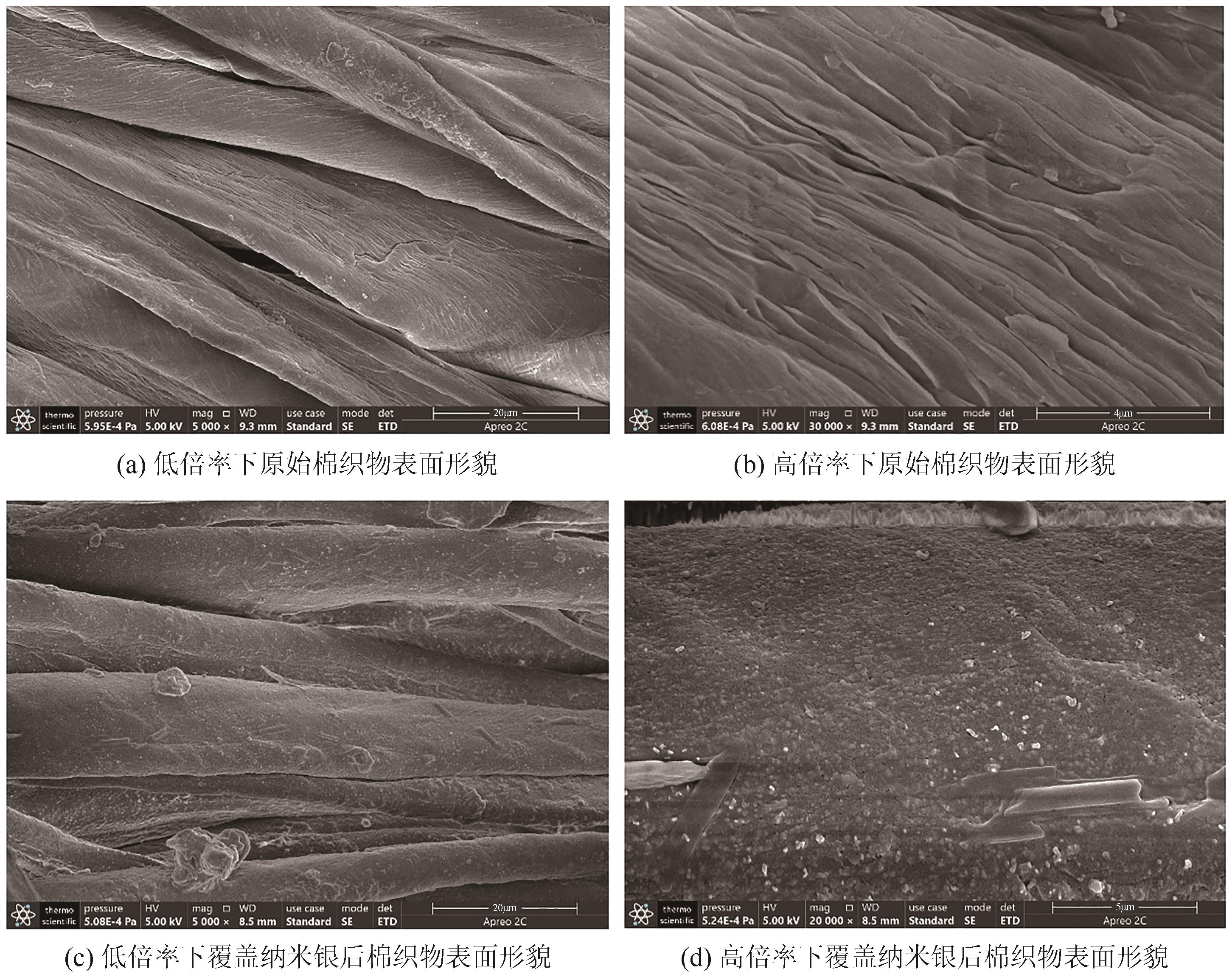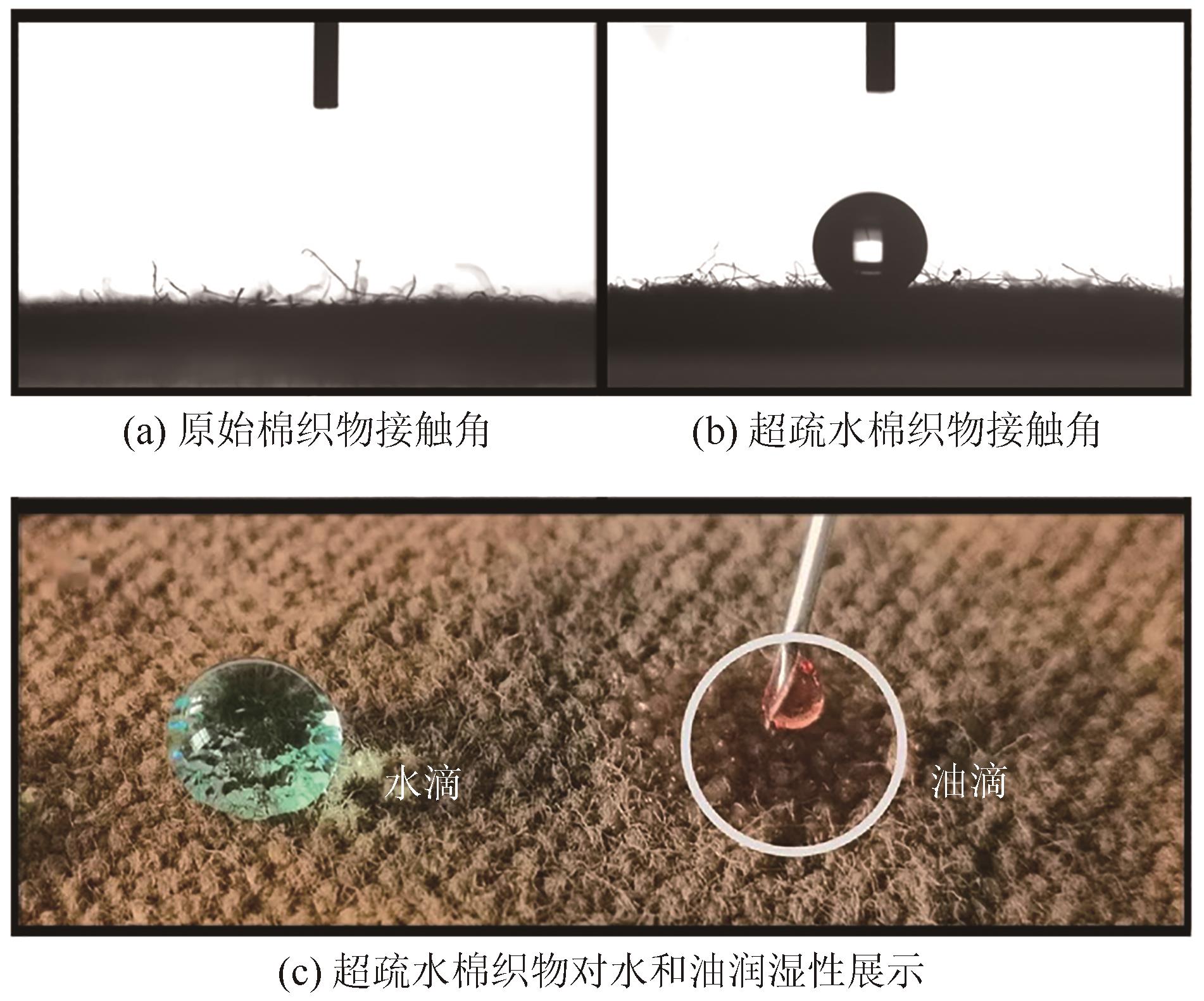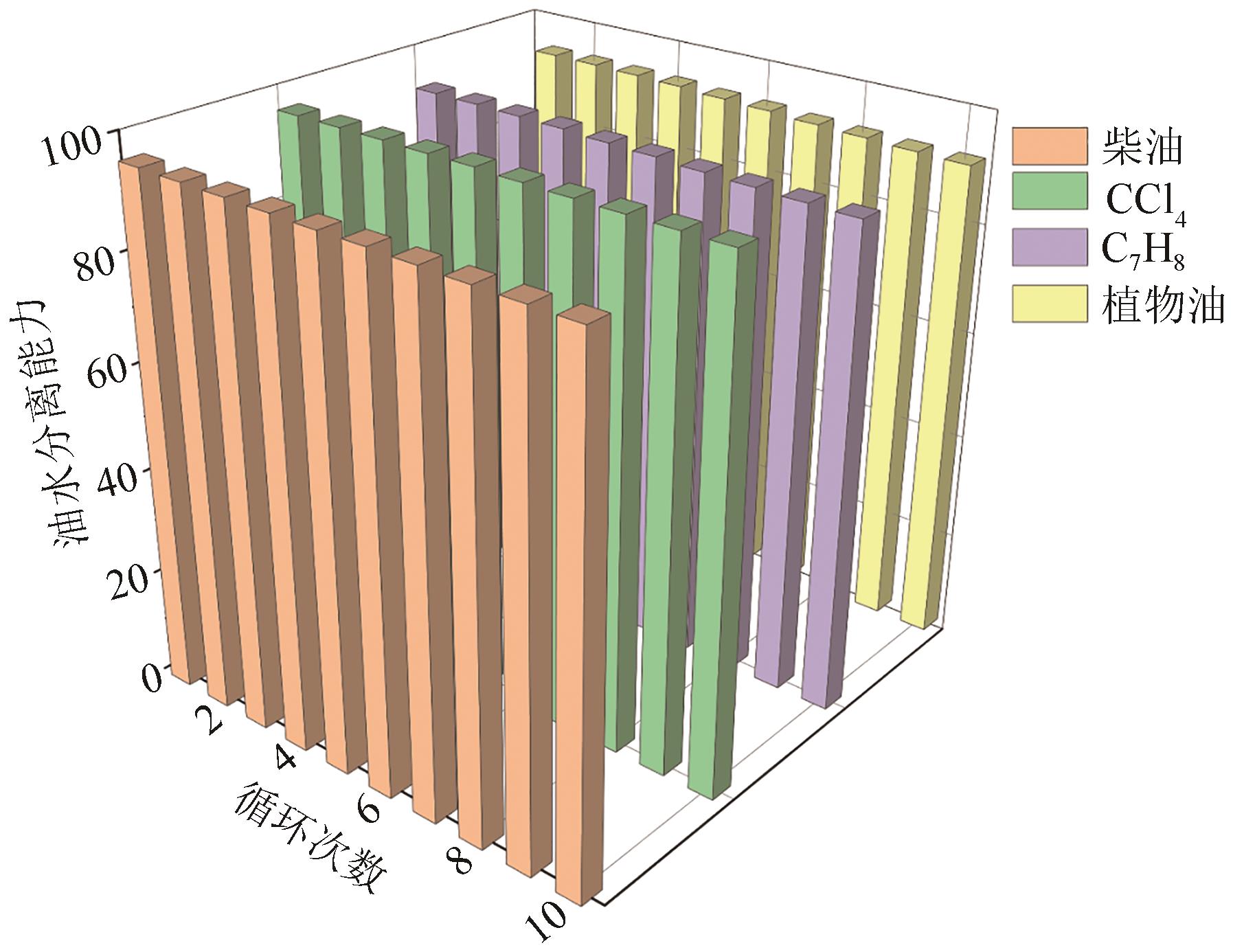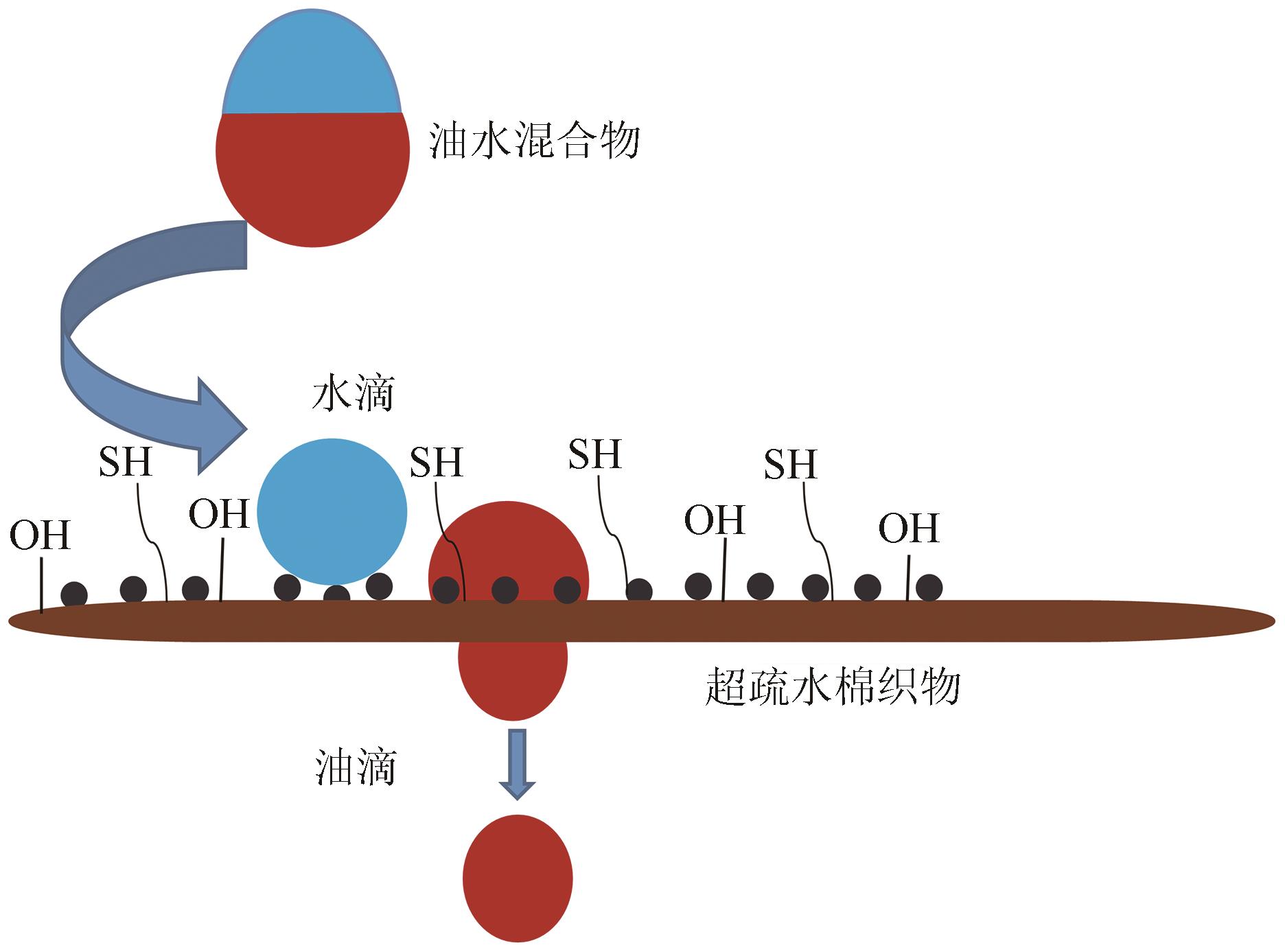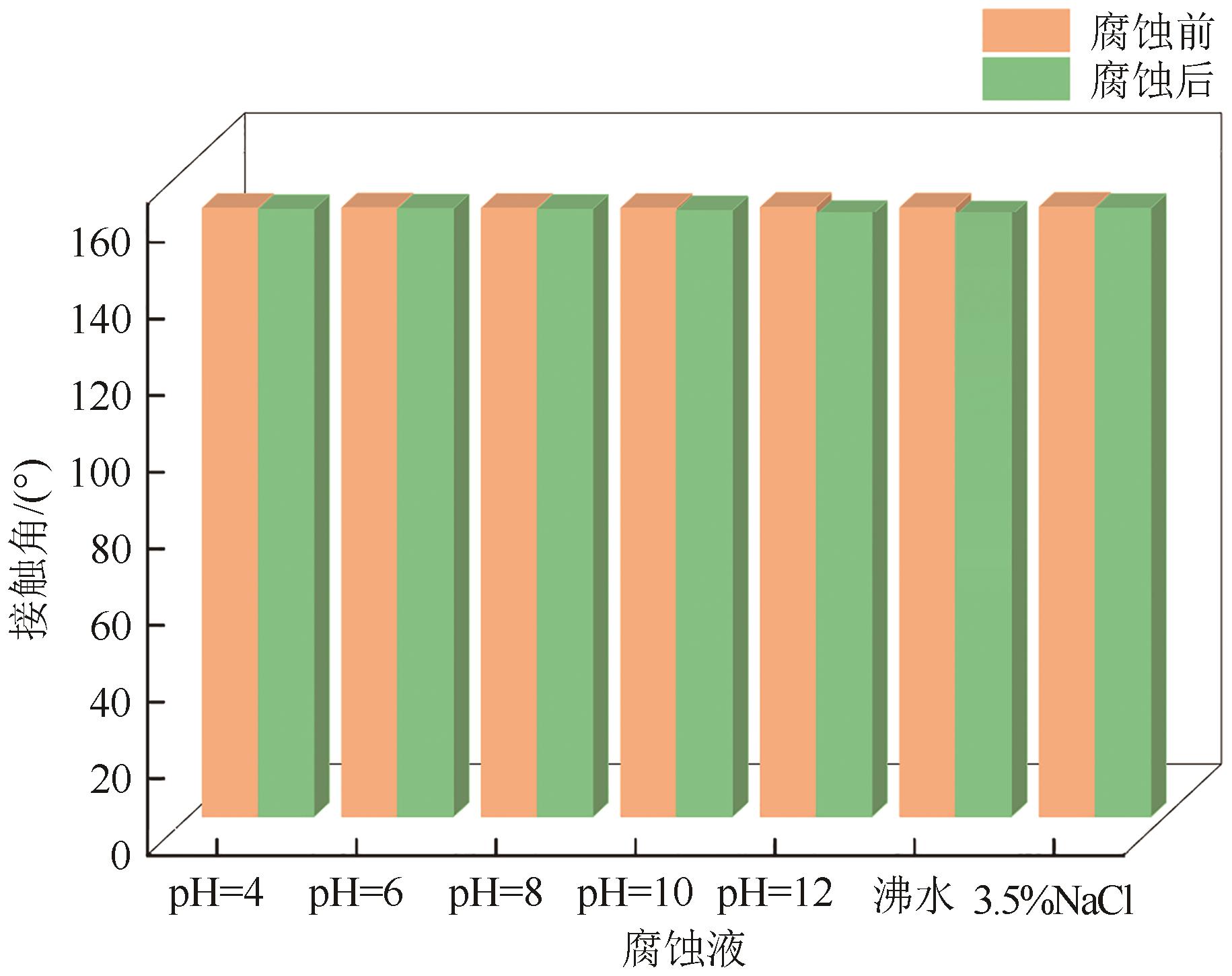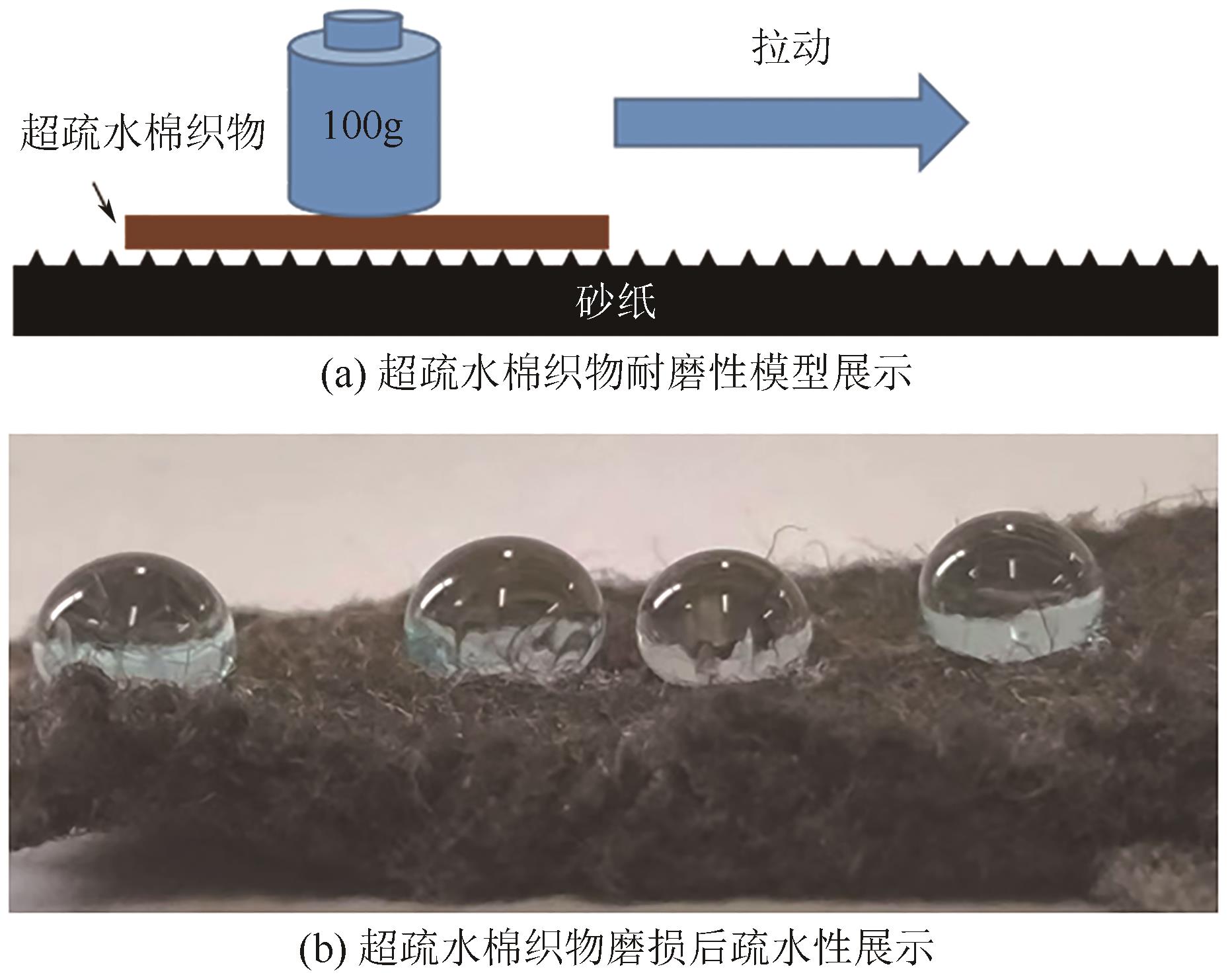Chemical Industry and Engineering Progress ›› 2023, Vol. 42 ›› Issue (12): 6490-6497.DOI: 10.16085/j.issn.1000-6613.2023-0092
• Materials science and technology • Previous Articles
Preparation of biomimetic superhydrophobic cotton fabric by gas phase adsorption and its oil-water separation performance
WANG Baixiang1,2( ), ZHANG Huining1(
), ZHANG Huining1( ), PENG Yaoqing1, REN Huimin1
), PENG Yaoqing1, REN Huimin1
- 1.School of Civil Engineering, Lanzhou University of Technology, Lanzhou 730050, Gansu, China
2.School of Civil Engineering, Lanzhou Institute of Technology, Lanzhou 730050, Gansu, China
-
Received:2023-01-19Revised:2023-05-29Online:2024-01-08Published:2023-12-25 -
Contact:ZHANG Huining
气相吸附制备仿生超疏水棉织物及其油水分离性能
- 1.兰州理工大学土木工程学院,甘肃 兰州 730050
2.兰州工业学院土木工程学院,甘肃 兰州 730050
-
通讯作者:张惠宁 -
作者简介:王百祥(1997—),男,硕士研究生,研究方向为吸附材料。E-mail:1658418638@qq.com。
CLC Number:
Cite this article
WANG Baixiang, ZHANG Huining, PENG Yaoqing, REN Huimin. Preparation of biomimetic superhydrophobic cotton fabric by gas phase adsorption and its oil-water separation performance[J]. Chemical Industry and Engineering Progress, 2023, 42(12): 6490-6497.
王百祥, 张惠宁, 彭耀清, 任慧敏. 气相吸附制备仿生超疏水棉织物及其油水分离性能[J]. 化工进展, 2023, 42(12): 6490-6497.
share this article
Add to citation manager EndNote|Ris|BibTeX
URL: https://hgjz.cip.com.cn/EN/10.16085/j.issn.1000-6613.2023-0092
| 序号 | 油水分离性能/% | 接触角 | 循环利用次数/次 | 文献来源 |
|---|---|---|---|---|
| 1 | 90 | 164.5° | 10 | 李维斌等[ |
| 2 | 82.8 | 160° | — | 陈扣琴等[ |
| 3 | 90.4 | 155.1° | — | 张彩宁等[ |
| 4 | 94 | 156° | 30 | 侯珂珂等[ |
| 5 | 96.4 | 164.4° | 10 | 本工作 |
| 序号 | 油水分离性能/% | 接触角 | 循环利用次数/次 | 文献来源 |
|---|---|---|---|---|
| 1 | 90 | 164.5° | 10 | 李维斌等[ |
| 2 | 82.8 | 160° | — | 陈扣琴等[ |
| 3 | 90.4 | 155.1° | — | 张彩宁等[ |
| 4 | 94 | 156° | 30 | 侯珂珂等[ |
| 5 | 96.4 | 164.4° | 10 | 本工作 |
| 1 | 聂宁, 俞博凡, 乔冰. 海洋污染损害碳稳定性同位素比值差异性溯源分析实验技术——以船舶溢油污染事故为例[J]. 海洋环境科学, 2021, 40(5): 782-789. |
| NIE Ning, YU Bofan, QIAO Bing. Experimental technique for traceability analysis of carbon stable isotope ratios of marine pollution damage—Take ship oil spill pollution accident as an example[J]. Marine Environmental Science, 2021, 40(5): 782-789. | |
| 2 | KASZYCKI Paweł, PETRYSZAK Przemysław, SUPEL Paulina. Bioremediation of A spent metalworking fluid with auto- and allochthonous bacterial consortia[J]. Ecological Chemistry and Engineering S, 2015, 22(2): 285-299. |
| 3 | 王志敏, 谢峻林, 梅书霞, 等. 浮法玻璃熔窑火焰空间石油焦部分替代重油燃烧的数值模拟[J]. 过程工程学报, 2020, 20(6): 737-744. |
| WANG Zhimin, XIE Junlin, MEI Shuxia, et al. Numerical simulation of combustion process of petroleum coke partially substituting heavy oil in combustion space of float glass furnace[J]. The Chinese Journal of Process Engineering, 2020, 20(6): 737-744. | |
| 4 | BACOSA Hernando P, KAMALANATHAN Manoj, CULLEN Joshua, et al. Marine snow aggregates are enriched in polycyclic aromatic hydrocarbons (PAHs) in oil contaminated waters: Insights from a mesocosm study[J]. Journal of Marine Science and Engineering, 2020, 8(10): 781. |
| 5 | 齐博浩, 刘长松, 赵欣生, 等. 超疏水超亲油304不锈钢网的制备及其油水分离性能[J]. 材料保护, 2021, 54(2): 44-49. |
| QI Bohao, LIU Changsong, ZHAO Xinsheng, et al. Preparation of superhydrophobic and super-oleophilicity 304 stainless steel mesh and its performance of oil-water separation[J]. Materials Protection, 2021, 54(2): 44-49. | |
| 6 | 王铎宇, 王欣. 亲油疏水型沙柳纤维状活性炭的制备及性能研究[J]. 化工新型材料, 2023, 51(5): 293-298. |
| WANG Doyu, WANG Xin. Preparation and properties of lipophilic and hydrophobic salix ACF[J]. New Chemical Materials, 2023, 51(5): 293-298. | |
| 7 | 余芳, 胡晓婧, 唐其金, 等. 具有可逆润湿性Bi2O3涂层在抗菌和油水分离中的应用[J]. 材料工程, 2021, 49(9): 167-174. |
| YU Fang, HU Xiaojing, TANG Qijin, et al. Antibacterial and oil-water separation applications of Bi2O3 coating with reversible wettability[J]. Journal of Materials Engineering, 2021, 49(9): 167-174. | |
| 8 | 曾佑林, 姜水生, 文华, 等. 水滴与聚氧化乙烯液滴撞击荷叶表面的实验对比分析[J]. 化工进展, 2021, 40(8): 4445-4455. |
| ZENG Youlin, JIANG Shuisheng, WEN Hua, et al. Comparative experiments and analysis of water droplet and PEO droplet impacting on the surface of lotus leaf[J]. Chemical Industry and Engineering Progress, 2021, 40(8): 4445-4455. | |
| 9 | 王百祥, 沈佳炯, 杨福生, 等. 超疏水玻璃制备及其抗菌性能分析[J]. 兰州工业学院学报, 2022, 29(3): 59-63. |
| WANG Baixiang, SHEN Jiajiong, YANG Fusheng, et al. Preparation of super hydrophobic glass and analysis of antibacterial properties[J]. Journal of Lanzhou Institute of Technology, 2022, 29(3): 59-63. | |
| 10 | 杨福生, 任永忠, 张振宇, 等. 用于油水分离的超疏水-超亲油沙子的制备及其性能[J]. 表面技术, 2021, 50(11): 165-171. |
| YANG Fusheng, REN Yongzhong, ZHANG Zhenyu, et al. Preparation and properties of superhydrophobic-superoleophilic sand for oil-water separation[J]. Surface Technology, 2021, 50(11): 165-171. | |
| 11 | WU Mingming, XIANG Bin, MU Peng, et al. Janus nanofibrous membrane with special micro-nanostructure for highly efficient separation of oil-water emulsion[J]. Separation and Purification Technology, 2022, 297: 121532. |
| 12 | 王子璇, 季静怡, 聂宜苹, 等. 利用聚多巴胺/叶酸制备超疏水棉织物[J]. 高分子材料科学与工程, 2021, 37(12): 103-110. |
| WANG Zixuan, JI Jingyi, NIE Yiping, et al. Preparation of super-hydrophobic cotton fabric using polydopamine/folic acid[J]. Polymer Materials Science & Engineering, 2021, 37(12): 103-110. | |
| 13 | YU Lisha, KANG Yanhui, TANG Hongding, et al. Functionalization of commercial sand core funnels as hydrophobic materials with novel physicochemical properties[J]. ACS Applied Materials & Interfaces, 2019, 11(7): 7510-7521. |
| 14 | WESTCOTT S L, OLDENBURG S, LEE R T, et al. Formation and adsorption of clusters of gold nanoparticles onto functionalized silica nanoparticle surfaces[J]. Langmuir, 1998, 14(19): 5396-5401. |
| 15 | 胡瑜兰, 杜彬彬, 潘力伟, 等. 聚丙烯腈-纳米银复合静电纺丝纤维膜的制备及其石窟文物微生物病害防治研究[J].复合材料学报, 2023, 40(7): 3986-3997. |
| HU Yulan, DU Binbin, PAN Liwei, et al. Preparation of polyacrylonitrile-nano-silver composite electrostatic spun fiber membrane and its research on microbial disease control of cave relics[J]. Acta Materiae Compositae Sinica, 2023, 40(7): 3986-3997. | |
| 16 | 杨福生, 王百祥, 张妍, 等. 纳米银协同沙子构筑超疏水表面及其性能研究[J]. 材料导报, 2022, 36(6): 39-43. |
| YANG Fusheng, WANG Baixiang, ZHANG Yan, et al. Study on preparation and properties of superhydrophobic surface with nano-silver and sand[J]. Materials Reports, 2022, 36(6): 39-43. | |
| 17 | 郭树虎, 于志家, 罗明宝, 等. 超疏水表面润湿理论研究进展[J]. 材料导报, 2012, 26(5): 74-78. |
| GUO Shuhu, YU Zhijia, LUO Mingbao, et al. Research progress in wetting theory of superhydrophobic surface[J]. Materials Review, 2012, 26(5): 74-78. | |
| 18 | XIANG Bin, SUN Qing, ZHONG Qi, et al. Current research situation and future prospect of superwetting smart oil/water separation materials[J]. Journal of Materials Chemistry A, 2022, 10(38): 20190-20217. |
| 19 | LOU Jing, SHI Songlin, MA Chen, et al. Suspended penetration wetting state of droplets on microstructured surfaces[J]. Science China Physics, Mechanics & Astronomy, 2021, 64(4): 244711. |
| 20 | 石彦龙, 冯晓娟, 杨锐花, 等. 超疏水超亲油玉米秸秆粉油污吸附剂的制备及其在油水分离中的应用[J]. 应用化学, 2020, 37(7): 793-802. |
| SHI Yanlong, FENG Xiaojuan, YANG Ruihua, et al. Preparation of superhydrophobic and superoleophilic corn straw fibers oil absorbents and application to the removal of spilled oil from water[J]. Chinese Journal of Applied Chemistry, 2020, 37(7): 793-802. | |
| 21 | 石彦龙, 杨武, 冯晓娟. 超疏水-超亲油棉织物的制备及在油水分离中的应用[J]. 高等学校化学学报, 2015, 36(9): 1724-1729. |
| SHI Yanlong, YANG Wu, FENG Xiaojuan. Fabrication of superhydrophobic-superoleophilic cotton fabric and its application in water-oil separation[J]. Chemical Journal of Chinese Universities, 2015, 36(9): 1724-1729. | |
| 22 | 李维斌, 张程, 刘军. 超疏水棉织物制备及其在油水过滤分离中应用[J]. 纺织学报, 2021, 42(8): 109-114. |
| LI Weibin, ZHANG Cheng, LIU Jun. Preparation of superhydrophobic coated cotton fabrics for oil-water separation[J]. Journal of Textile Research, 2021, 42(8): 109-114. | |
| 23 | 陈扣琴, 王黎明, 郝慧敏, 等. 花生壳纳米纤维素超疏水气凝胶的制备及在棉织物上的应用[J]. 功能材料, 2022, 53(2): 2107-2113. |
| CHEN Kouqin, WANG Liming, HAO Huimin, et al. Preparation of peanut shell nano-cellulose superhydrophobic aerogel and its application on cotton fabric[J]. Journal of Functional Materials, 2022, 53(2): 2107-2113. | |
| 24 | 张彩宁, 王煦漫, 刘东升, 等. 含纳米明胶超疏水棉织物的制备及其性能[J]. 印染, 2019, 45(23): 11-15. |
| ZHANG Caining, WANG Xuman, LIU Dongsheng, et al. Preparation and properties of super hydrophobic cotton fabric containing nano gelatin[J]. Dyeing & Finishing, 2019, 45(23): 11-15. | |
| 25 | 侯珂珂, 陈新华, 张万强, 等. 超疏水性棉织物的制备及其油水分离应用研究[J]. 产业用纺织品, 2020, 38(9): 22-28. |
| HOU Keke, CHEN Xinhua, ZHANG Wanqiang, et al. Preparation of superhydrophobic cotton fabric and its application on the oil-water separation[J]. Technical Textiles, 2020, 38(9): 22-28. | |
| 26 | HAN Xiao, WU Zhaodi, YANG Yi, et al. Facile preparation of a porous biochar derived from waste crab shell with high removal performance for diesel[J]. Journal of Renewable Materials, 2021, 9(8): 1377-1391. |
| 27 | DE SOUZA E J, BRINKMANN M, MOHRDIECK C, et al. Enhancement of capillary forces by multiple liquid bridges[J]. Langmuir, 2008, 24(16): 8813-8820. |
| 28 | LI Haoyu, ZHONG Qi, SUN Qing, et al. Upcycling waste pine nut shell membrane for highly efficient separation of crude oil-in-water emulsion[J]. Langmuir, 2022, 38(11): 3493-3500. |
| 29 | ZHAN Yanlong, YU Sirong, AMIRFAZLI Alidad, et al. Recent advances in antibacterial superhydrophobic coatings[J]. Advanced Engineering Materials, 2022, 24(4): 2101053. |
| [1] | WANG Xin, WANG Bingbing, YANG Wei, XU Zhiming. Anti-scale and anti-corrosion properties of PDA/PTFE superhydrophobic coating on metal surface [J]. Chemical Industry and Engineering Progress, 2023, 42(8): 4315-4321. |
| [2] | CHEN Xiangli, LI Qianqian, ZHANG Tian, LI Biao, LI Kangkang. Research progress on self-healing oil/water separation membranes [J]. Chemical Industry and Engineering Progress, 2023, 42(7): 3600-3610. |
| [3] | LIU Zhanjian, FU Yuxin, REN Lina, ZHANG Xiguang, YUAN Zhongtao, YANG Nan, WANG Huaiyuan. New research progress of superhydrophobic coatings in the field of anti-corrosion and anti-scaling [J]. Chemical Industry and Engineering Progress, 2023, 42(6): 2999-3011. |
| [4] | LI Dongyan, ZHOU Jian, JIANG Qian, MIAO Kai, NI Shiying, ZOU Dong. Progress in preparations and applications of silicon carbide ceramic membranes [J]. Chemical Industry and Engineering Progress, 2023, 42(12): 6399-6408. |
| [5] | CUI Tengda, WEN Hua, ZHAO Ying. Comparative analysis of deposition characteristics of modified droplets impacting lotus leaf surface [J]. Chemical Industry and Engineering Progress, 2023, 42(11): 5882-5890. |
| [6] | LU Tao, HU Jiayi, XU Cheng, HU Xinlin, GUO Qingyang, LI Meng. Facile synthesis of superhydrophobic sponge for efficient separation of oil/water mixture [J]. Chemical Industry and Engineering Progress, 2023, 42(10): 5353-5362. |
| [7] | LIU Zhanjian, YANG Jinyue, JING Jing, ZHANG Xiguang, WANG Huaiyuan. Research progress of three-dimensional super-wetting porous materials in oil-water separation [J]. Chemical Industry and Engineering Progress, 2023, 42(1): 310-320. |
| [8] | ZHAN Xun, CHEN Jian, YANG Zhaozhe, WU Guomin, KONG Zhenwu, SHEN Kuizhong. Progress on superhydrophobic materials from nanocellulose [J]. Chemical Industry and Engineering Progress, 2022, 41(8): 4303-4313. |
| [9] | ZHU Xuedan, YAO Yali, MA Lili, WANG Jiaxin, YANG Jie, PENG Lei, HE Jinmei, QU Mengnan. Progress in preparation and application of superhydrophobic materials based on polyvinyl chloride [J]. Chemical Industry and Engineering Progress, 2022, 41(7): 3676-3688. |
| [10] | YE Zequan, WU Qingyun, GU Lin. Recent progress in cellulose-based materials for oil-water separation [J]. Chemical Industry and Engineering Progress, 2022, 41(6): 3038-3050. |
| [11] | LI Zheng, NIU Jingdong, HE Guangze, ZHANG Lanhe, ZHANG Haifeng. Preparation of PVDF-PFTS/SiO2 membrane and its resistance mixed fouling performance [J]. Chemical Industry and Engineering Progress, 2022, 41(5): 2713-2721. |
| [12] | LIANG Ge, HUANG Xiangfeng, LIU Wanqi, XIONG Yongjiao, PENG Kaiming. A review of superhydrophobic three-dimensional porous materials for oil/water separation of emulsions [J]. Chemical Industry and Engineering Progress, 2022, 41(12): 6557-6572. |
| [13] | YUAN Yuting, FENG Yongchao, YI Honghong, TANG Xiaolong, YU Qingjun, ZHANG Yuanyuan, WEI Jinghui, MENG Xianzheng. Research progress of superhydrophobic surface materials and its application in air pollution control [J]. Chemical Industry and Engineering Progress, 2021, 40(8): 4327-4345. |
| [14] | LEI Yu, TIAN Mengmeng, ZHANG Xinya, JIANG Xiang. Research progress on the self-healing property and applications of superhydrophobic surfaces [J]. Chemical Industry and Engineering Progress, 2021, 40(5): 2624-2633. |
| [15] | YAN Hongqin, ZHENG Wengrui, ZHANG Guiyu, WANG Yu, WANG Mengran, ZHU Minhui. Preparation of hydrophobic/oleophilic luffa and its application in oil-water separation [J]. Chemical Industry and Engineering Progress, 2021, 40(5): 2893-2899. |
| Viewed | ||||||
|
Full text |
|
|||||
|
Abstract |
|
|||||

